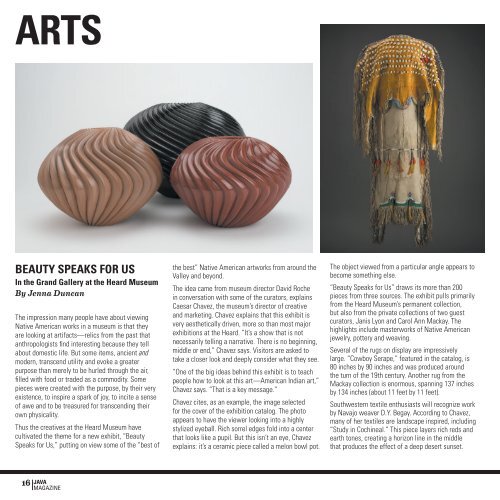Java.FEB.2017
Create successful ePaper yourself
Turn your PDF publications into a flip-book with our unique Google optimized e-Paper software.
ARTS<br />
BEAUTY SPEAKS FOR US<br />
In the Grand Gallery at the Heard Museum<br />
By Jenna Duncan<br />
The impression many people have about viewing<br />
Native American works in a museum is that they<br />
are looking at artifacts—relics from the past that<br />
anthropologists find interesting because they tell<br />
about domestic life. But some items, ancient and<br />
modern, transcend utility and evoke a greater<br />
purpose than merely to be hurled through the air,<br />
filled with food or traded as a commodity. Some<br />
pieces were created with the purpose, by their very<br />
existence, to inspire a spark of joy, to incite a sense<br />
of awe and to be treasured for transcending their<br />
own physicality.<br />
Thus the creatives at the Heard Museum have<br />
cultivated the theme for a new exhibit, “Beauty<br />
Speaks for Us,” putting on view some of the “best of<br />
the best” Native American artworks from around the<br />
Valley and beyond.<br />
The idea came from museum director David Roche<br />
in conversation with some of the curators, explains<br />
Caesar Chavez, the museum’s director of creative<br />
and marketing. Chavez explains that this exhibit is<br />
very aesthetically driven, more so than most major<br />
exhibitions at the Heard. “It’s a show that is not<br />
necessarily telling a narrative. There is no beginning,<br />
middle or end,” Chavez says. Visitors are asked to<br />
take a closer look and deeply consider what they see.<br />
“One of the big ideas behind this exhibit is to teach<br />
people how to look at this art—American Indian art,”<br />
Chavez says. “That is a key message.”<br />
Chavez cites, as an example, the image selected<br />
for the cover of the exhibition catalog. The photo<br />
appears to have the viewer looking into a highly<br />
stylized eyeball. Rich sorrel edges fold into a center<br />
that looks like a pupil. But this isn’t an eye, Chavez<br />
explains: it’s a ceramic piece called a melon bowl pot.<br />
The object viewed from a particular angle appears to<br />
become something else.<br />
“Beauty Speaks for Us” draws its more than 200<br />
pieces from three sources. The exhibit pulls primarily<br />
from the Heard Museum’s permanent collection,<br />
but also from the private collections of two guest<br />
curators, Janis Lyon and Carol Ann Mackay. The<br />
highlights include masterworks of Native American<br />
jewelry, pottery and weaving.<br />
Several of the rugs on display are impressively<br />
large. “Cowboy Serape,” featured in the catalog, is<br />
80 inches by 90 inches and was produced around<br />
the turn of the 19th century. Another rug from the<br />
Mackay collection is enormous, spanning 137 inches<br />
by 134 inches (about 11 feet by 11 feet).<br />
Southwestern textile enthusiasts will recognize work<br />
by Navajo weaver D.Y. Begay. According to Chavez,<br />
many of her textiles are landscape inspired, including<br />
“Study in Cochineal.” This piece layers rich reds and<br />
earth tones, creating a horizon line in the middle<br />
that produces the effect of a deep desert sunset.<br />
16 JAVA<br />
MAGAZINE


















